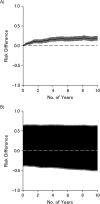Nonparametric Bounds for the Risk Function
- PMID: 30698633
- PMCID: PMC6438811
- DOI: 10.1093/aje/kwz013
Nonparametric Bounds for the Risk Function
Abstract
Nonparametric bounds for the risk difference are straightforward to calculate and make no untestable assumptions about unmeasured confounding or selection bias due to missing data (e.g., dropout). These bounds are often wide and communicate uncertainty due to possible systemic errors. An illustrative example is provided.
Keywords: bias; bounds; inference; missing data.
© The Author(s) 2019. Published by Oxford University Press on behalf of the Johns Hopkins Bloomberg School of Public Health. All rights reserved. For permissions, please e-mail: journals.permissions@oup.com.
Figures

References
-
- Robins JM. The analysis of randomized and nonrandomized AIDS treatment trials using a new approach to causal inference in longitudinal studies In: Sechrest L, Freeman H, Mulley A, eds. Health Service Research Methodology: A Focus on AIDS. Washington, DC: US Public Health Service; 1989:113–15959.
-
- Manski CF. Nonparametric bounds on treatment effects. Am Econ Rev. 1990;80(2):319–323.
-
- Balke A, Pearl J. Bounds on treatment effects from studies with imperfect compliance. J Am Stat Assoc. 1997;92(439):1171–1176.
-
- Robins JM. Confidence intervals for causal parameters. Stat Med. 1988;7(7):773–785. - PubMed
-
- Cole SR, Frangakis CE. The consistency statement in causal inference: a definition or an assumption? Epidemiology. 2009;20(1):3–5. - PubMed

